概述 Commond-Line ASP.NET結構文件 Startup 配置文件 中間件和依賴註入 依賴註入原理 框架自帶的依賴註入(IServiceCollection) 依賴註入生命周期 依賴註入使用方式 通過構造函數 MVC的ActionAction中可以使用 [FromServices]來註 ...
概述
Commond-Line
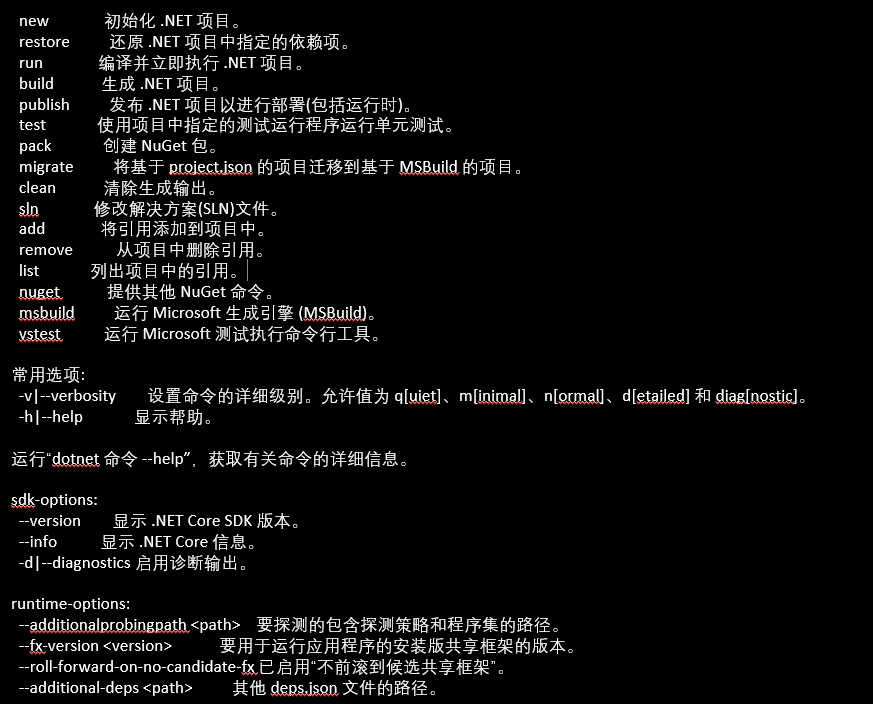

ASP.NET結構文件
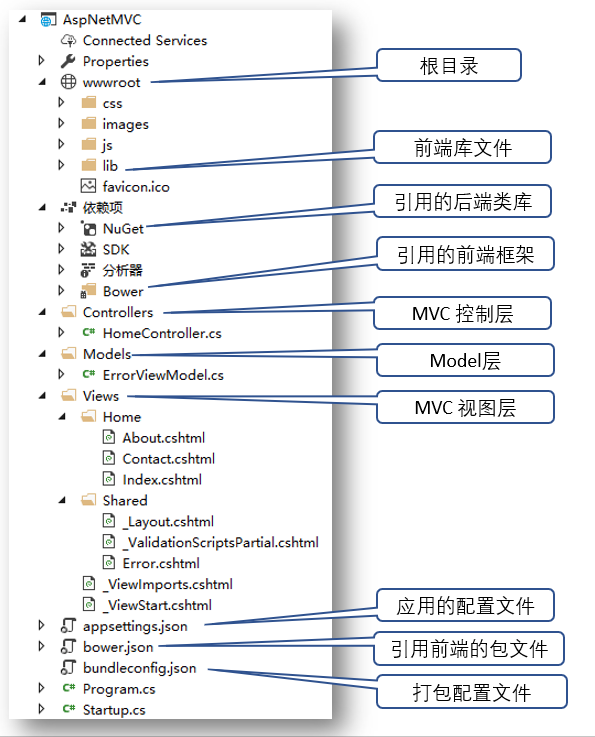
Startup
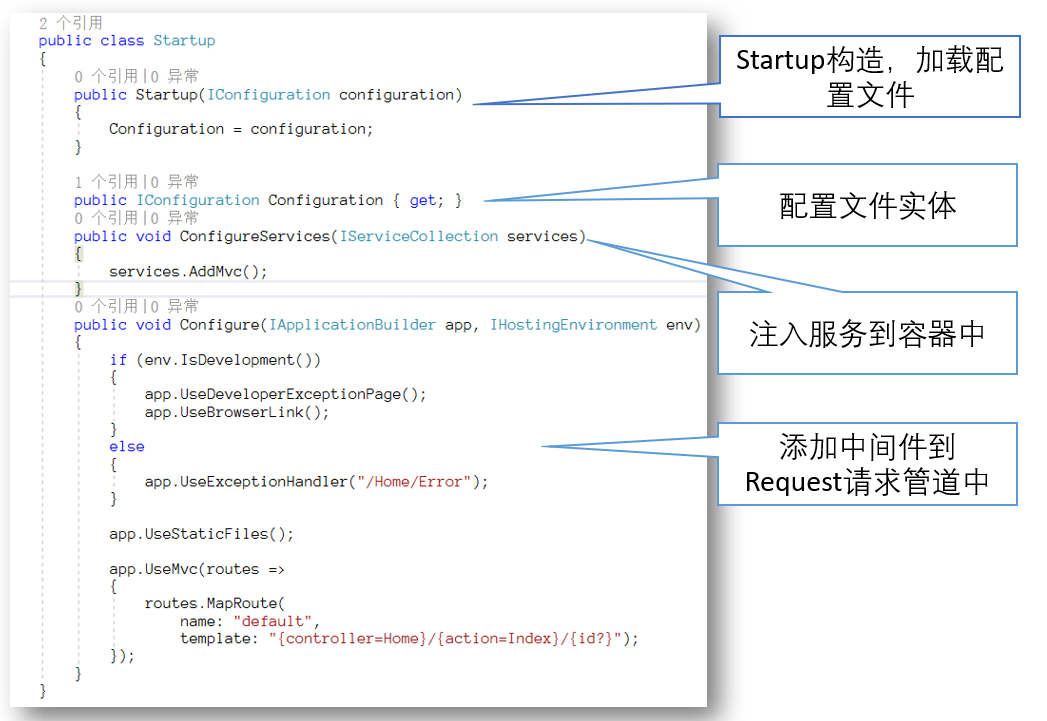
配置文件
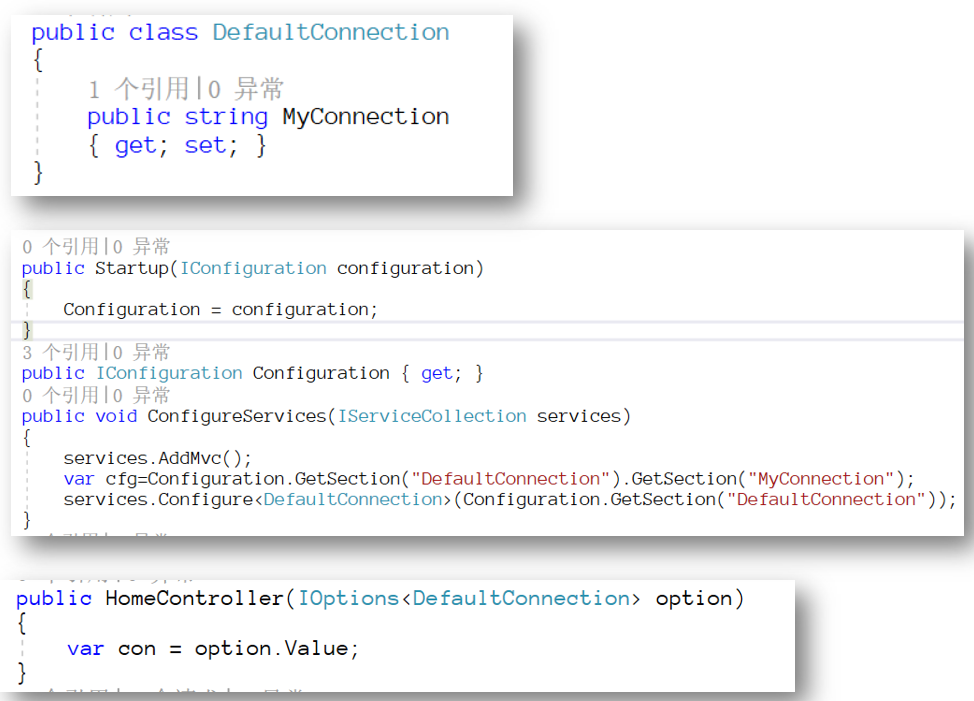
中間件和依賴註入
依賴註入原理
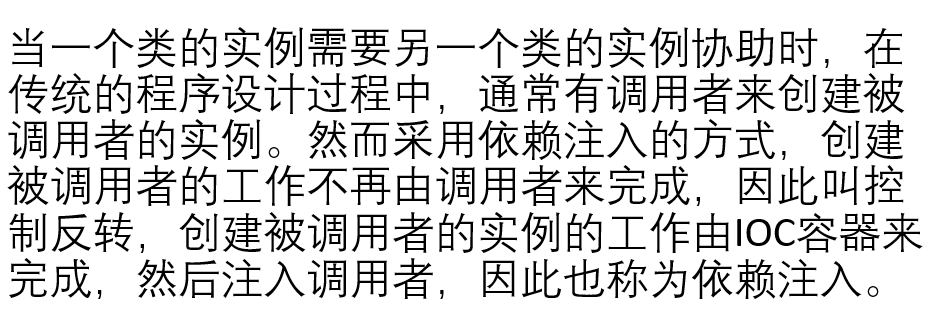
框架自帶的依賴註入(IServiceCollection)
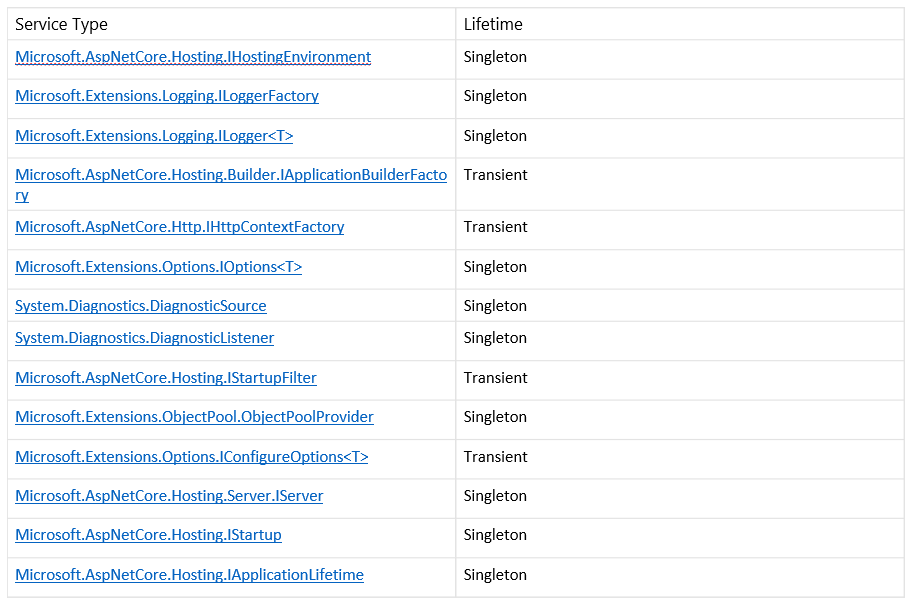
依賴註入生命周期

依賴註入使用方式
- 通過構造函數
- MVC的ActionAction中可以使用 [FromServices]來註入對象、
中間件(MiddleWare)
Use:進入中間件http管道模式,
Map:映射分支 Run:
執行,並返回Response

public void Configure(IApplicationBuilder app, IHostingEnvironment env)
{
app.UseMyMiddleware();
}
public class MyMiddleware
{
private readonly RequestDelegate _next;
public MyMiddleware(RequestDelegate next)
{
_next = next;
}
public Task Invoke(HttpContext context)
{
//這裡是獲取context信息後處理的代碼
return this._next(context);
}
}
public static class MyMiddlewareExtensions
{
public static IApplicationBuilder UseMyMiddleware(
this IApplicationBuilder builder)
{
return builder.UseMiddleware<MyMiddlewareMiddleware>();
}
}

中間件的執行要註意順序,因為可以終止http管道的執行
框架自帶中間件

ORM
Entity Framework Core
官方地址:https://docs.microsoft.com/zh-cn/ef/core/
services.AddDbContext<SchoolContext>(options =>options.UseSqlServer(Configuration.GetConnectionString("DefaultConnection")));
Entity Framework Core-Code First
//程式包管理控制項台 Install-Package Microsoft.EntityFrameworkCore.SqlServer Install-Package Microsoft.EntityFrameworkCore.Tools Install-Package Microsoft.VisualStudio.Web.CodeGeneration.Design
從資料庫生成模型
Scaffold-DbContext "Server=(localdb)\mssqllocaldb;Database=Blogging;Trusted_Connection=True;" Microsoft.EntityFrameworkCore.SqlServer -OutputDir Models
併發控制

//特性方式
public class Person
{
public int PersonId { get; set; }
[ConcurrencyCheck]
public string LastName { get; set; }
public string FirstName { get; set; }
}
//特性API方式
class MyContext : DbContext
{
public DbSet<Person> People { get; set; }
protected override void OnModelCreating(ModelBuilder modelBuilder)
{
modelBuilder.Entity<Person>()
.Property(p => p.LastName)
.IsConcurrencyToken();
}
}
public class Person
{
public int PersonId { get; set; }
public string LastName { get; set; }
public string FirstName { get; set; }
}
//特性時間戳
public class Blog
{
public int BlogId { get; set; }
public string Url { get; set; }
[Timestamp]
public byte[] Timestamp { get; set; }
}
//時間戳
class MyContext : DbContext
{
public DbSet<Blog> Blogs { get; set; }
protected override void OnModelCreating(ModelBuilder modelBuilder)
{
modelBuilder.Entity<Blog>()
.Property(p => p.Timestamp)
.IsRowVersion();
}
}
public class Blog
{
public int BlogId { get; set; }
public string Url { get; set; }
public byte[] Timestamp { get; set; }
}

Dapper
官方地址:https://github.com/StackExchange/Dapper
許可權驗證
概念
Authentication:認證,通過自定義或三方的方式,確定用戶有效性,並分配用戶一定身份
Authorization:授權,決定用戶可以做什麼,可以帶上角色或策略來授權,並且是能過Controller或Action上的特性Authorize來授權的。
驗證方式
ConfigureServices中

//註入驗證 2.0
services.AddAuthentication(options =>
{
options.DefaultChallengeScheme = "MyCookieAuthenticationScheme";
options.DefaultSignInScheme = "MyCookieAuthenticationScheme";
options.DefaultAuthenticateScheme = "MyCookieAuthenticationScheme";
})
.AddCookie("MyCookieAuthenticationScheme", opt =>
{
opt.LoginPath = new PathString("/login");
opt.AccessDeniedPath = new PathString("/login");
opt.LogoutPath = new PathString("/login");
opt.Cookie.Path = "/";
});

Configure中
app.UseAuthentication();
登錄驗證

public class UserTestController : Controller
{
[HttpGet("users")]
[Authorize(Roles = "admin,system")]
public IActionResult Index()
{ return View(); }
[HttpGet("login")]
public IActionResult Login(string returnUrl)
{
//1、如果登錄用戶已經Authenticated,提示請勿重覆登錄
if (HttpContext.User.Identity.IsAuthenticated)
{
return View("Error", new string[] { "您已經登錄!" });
}else//記錄轉入地址
{
ViewBag.returnUrl = returnUrl;
return View();}
}


[AllowAnonymous]
[HttpPost("login")]
public IActionResult Login(string username, string returnUrl)
{
//2、登錄後設置驗證
if (username == "gsw")
{
var claims = new Claim[]{
new Claim(ClaimTypes.Role, "admin"),
new Claim(ClaimTypes.Name,"桂素偉")
};
HttpContext.SignInAsync("MyCookieAuthenticationScheme",new ClaimsPrincipal(new ClaimsIdentity(claims, "Cookie")));
//給User賦值
var claPris = new ClaimsPrincipal();
claPris.AddIdentity(new ClaimsIdentity(claims));
HttpContext.User = claPris;
return new RedirectResult(returnUrl == null ? "users" : returnUrl);
}
else
{
return View();
}
}

UI訪問

//3、UI上訪問驗證信息
@if (User.IsInRole("abc"))
{
<p>你好: @User.Identity.Name</p>
<a href="更高許可權">更高許可權</a>
}

許可權中間件

/// <summary>
/// 許可權中間件
/// </summary>
public class PermissionMiddleware
{
/// <summary>
/// 管道代理對象
/// </summary>
private readonly RequestDelegate _next;
/// <summary>
/// 許可權中間件構造
/// </summary>
/// <param name="next">管道代理對象</param>
/// <param name="permissionResitory">許可權倉儲對象</param>
/// <param name="option">許可權中間件配置選項</param>
public PermissionMiddleware(RequestDelegate next)
{
_next = next;
}
/// <summary>
/// 調用管道
/// </summary>
/// <param name="context"></param>
/// <returns></returns>
public Task Invoke(HttpContext context)
{
return this._next(context);
}
}

自定義策略

/// <summary>
/// 許可權授權Handler
/// </summary>
public class PermissionHandler : AuthorizationHandler<PermissionRequirement>
{
/// <summary>
/// 用戶許可權
/// </summary>
public List<Permission> Permissions { get; set; }
protected override Task HandleRequirementAsync(AuthorizationHandlerContext context, PermissionRequirement requirement)
{
//賦值用戶許可權
Permissions = requirement.Permissions;
//從AuthorizationHandlerContext轉成HttpContext,以便取出表求信息
var httpContext = (context.Resource as Microsoft.AspNetCore.Mvc.Filters.AuthorizationFilterContext).HttpContext;
//請求Url
var questUrl = httpContext.Request.Path.Value.ToLower();
//是否經過驗證
var isAuthenticated = httpContext.User.Identity.IsAuthenticated;
if (isAuthenticated)
{
//許可權中是否存在請求的url
if (Permissions.GroupBy(g => g.Url).Where(w => w.Key.ToLower() == questUrl).Count() > 0)
{
var name = httpContext.User.Claims.SingleOrDefault(s => s.Type == requirement.ClaimType).Value;
//驗證許可權
if (Permissions.Where(w => w.Name == name && w.Url.ToLower() == questUrl).Count() > 0)
{
context.Succeed(requirement);
}
else
{
//無許可權跳轉到拒絕頁面
httpContext.Response.Redirect(requirement.DeniedAction);
}
}
else
{
context.Succeed(requirement);
}
}
return Task.CompletedTask;
}
}

自定義策略-JWT

/// <summary>
/// 許可權授權Handler
/// </summary>
public class PermissionHandler : AuthorizationHandler<PermissionRequirement>
{
/// <summary>
/// 驗證方案提供對象
/// </summary>
public IAuthenticationSchemeProvider Schemes { get; set; }
/// <summary>
/// 自定義策略參數
/// </summary>
public PermissionRequirement Requirement
{ get; set; }
/// <summary>
/// 構造
/// </summary>
/// <param name="schemes"></param>
public PermissionHandler(IAuthenticationSchemeProvider schemes)
{
Schemes = schemes;
}
protected override async Task HandleRequirementAsync(AuthorizationHandlerContext context, PermissionRequirement requirement)
{
////賦值用戶許可權
Requirement = requirement;
//從AuthorizationHandlerContext轉成HttpContext,以便取出表求信息
var httpContext = (context.Resource as Microsoft.AspNetCore.Mvc.Filters.AuthorizationFilterContext).HttpContext;
//請求Url
var questUrl = httpContext.Request.Path.Value.ToLower();
//判斷請求是否停止
var handlers = httpContext.RequestServices.GetRequiredService<IAuthenticationHandlerProvider>();
foreach (var scheme in await Schemes.GetRequestHandlerSchemesAsync())
{
var handler = await handlers.GetHandlerAsync(httpContext, scheme.Name) as IAuthenticationRequestHandler;
if (handler != null && await handler.HandleRequestAsync())
{
context.Fail();
return;
}
}
//判斷請求是否擁有憑據,即有沒有登錄
var defaultAuthenticate = await Schemes.GetDefaultAuthenticateSchemeAsync();
if (defaultAuthenticate != null)
{
var result = await httpContext.AuthenticateAsync(defaultAuthenticate.Name);
//result?.Principal不為空即登錄成功
if (result?.Principal != null)
{
httpContext.User = result.Principal;
//許可權中是否存在請求的url
if (Requirement.Permissions.GroupBy(g => g.Url).Where(w => w.Key.ToLower() == questUrl).Count() > 0)
{
var name = httpContext.User.Claims.SingleOrDefault(s => s.Type == requirement.ClaimType).Value;
//驗證許可權
if (Requirement.Permissions.Where(w => w.Name == name && w.Url.ToLower() == questUrl).Count() <= 0)
{
//無許可權跳轉到拒絕頁面
httpContext.Response.Redirect(requirement.DeniedAction);
}
}
context.Succeed(requirement);
return;
}
}
//判斷沒有登錄時,是否訪問登錄的url,並且是Post請求,並且是form表單提交類型,否則為失敗
if (!questUrl.Equals(Requirement.LoginPath.ToLower(), StringComparison.Ordinal) && (!httpContext.Request.Method.Equals("POST")
|| !httpContext.Request.HasFormContentType))
{
context.Fail();
return;
}
context.Succeed(requirement);
}
}



